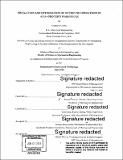Simulation and optimization of outbound operations in an e-grocer's warehouse
Author(s)
Costa, Gustavo (Gustavo Henrique De Faria Costa)
DownloadFull printable version (9.177Mb)
Other Contributors
Leaders for Global Operations Program.
Advisor
Kamal Youcef-Toumi and Yanchong (Karen) Zheng.
Terms of use
Metadata
Show full item recordAbstract
A second wave of online grocery retailers ("e-grocers") emerged in late 2000's after dot.com companies, such as Webvan, Streamline and Homegrocer, failed to break into the grocery market despite investing heavily on automated warehouses and operations. The key success factors for e-grocers identified by literature after studying first-wave players is their ability to increase asset utilization, while adopting a cost-efficient delivery and service level. This thesis focused on improving utilization of a typical e-grocer warehouse with upstream order sortation by alleviating its mechanical throughput bottleneck: the outbound processes. Batching mechanisms are used by warehouses to consolidate orders with a certain delivery time in the same picking and routing optimization batches. Increasing number of batches eliminates WIP ("work-in-progress") inventory and increases throughput by improving area utilization, with the trade-off of higher picking and delivery costs, due to sub-optimal picking paths and delivery routes. This thesis proposes a method to determine the optimal number of batches minimizing fixed and delivery costs per order for different warehouse capacities. The proposed optimal number of batches and a set of lean principles were then applied to a case study to simulate, through a 3D discrete-time event simulation package, a new design and process for outbound operations. Statistical distributions were used for bags arrival rates and process cycle times. The design also leveraged material handling equipment and automation solutions for the shipment label application and bags sortation processes, reducing manual labor and distances walked by workers.
Description
Thesis: M.B.A., Massachusetts Institute of Technology, Sloan School of Management, in conjunction with the Leaders for Global Operations Program at MIT, 2018. Thesis: S.M., Massachusetts Institute of Technology, Department of Mechanical Engineering, in conjunction with the Leaders for Global Operations Program at MIT, 2018. Cataloged from PDF version of thesis. Includes bibliographical references (pages 58-59).
Date issued
2018Department
Leaders for Global Operations Program at MIT; Massachusetts Institute of Technology. Department of Mechanical Engineering; Sloan School of ManagementPublisher
Massachusetts Institute of Technology
Keywords
Sloan School of Management., Mechanical Engineering., Leaders for Global Operations Program.